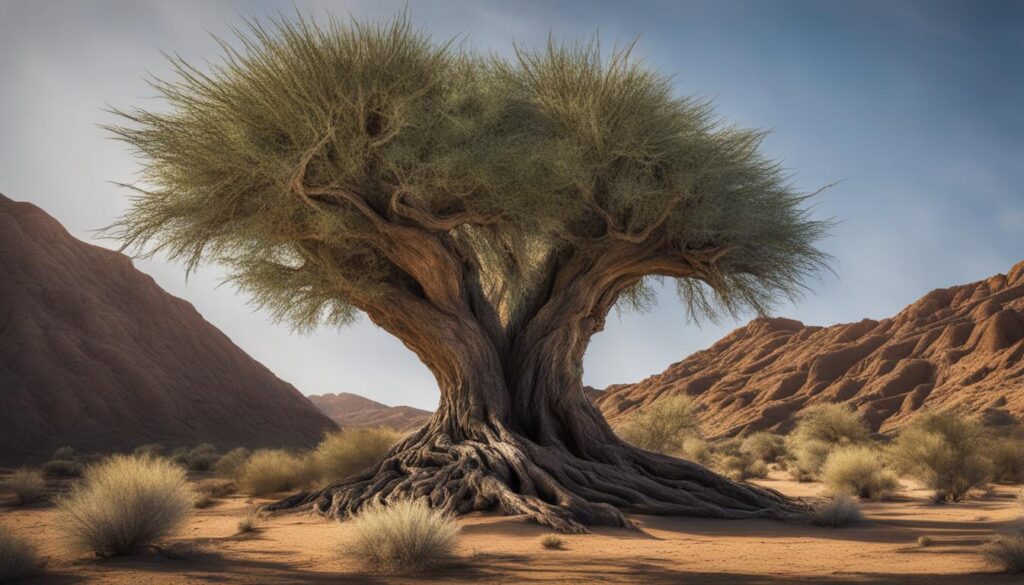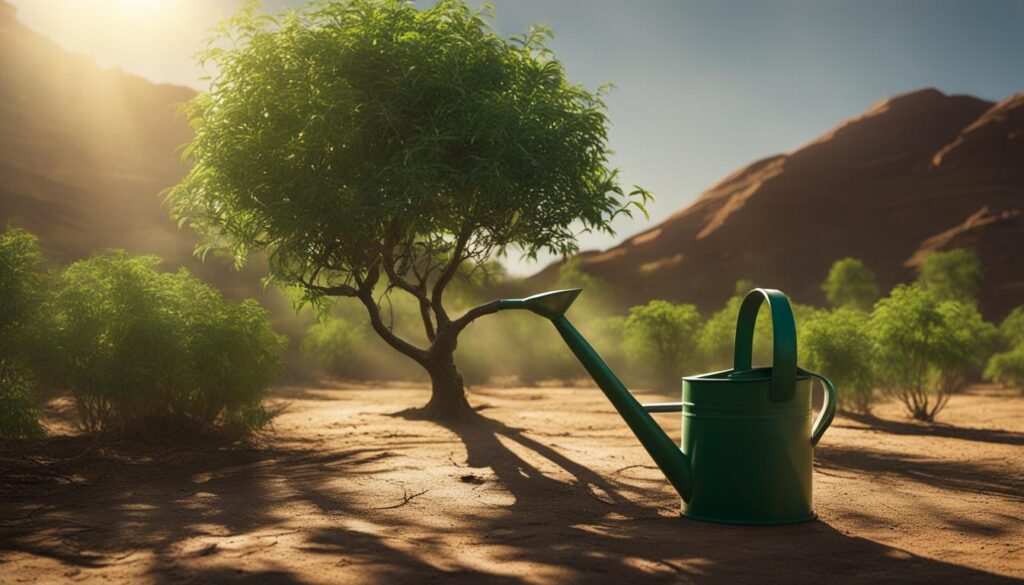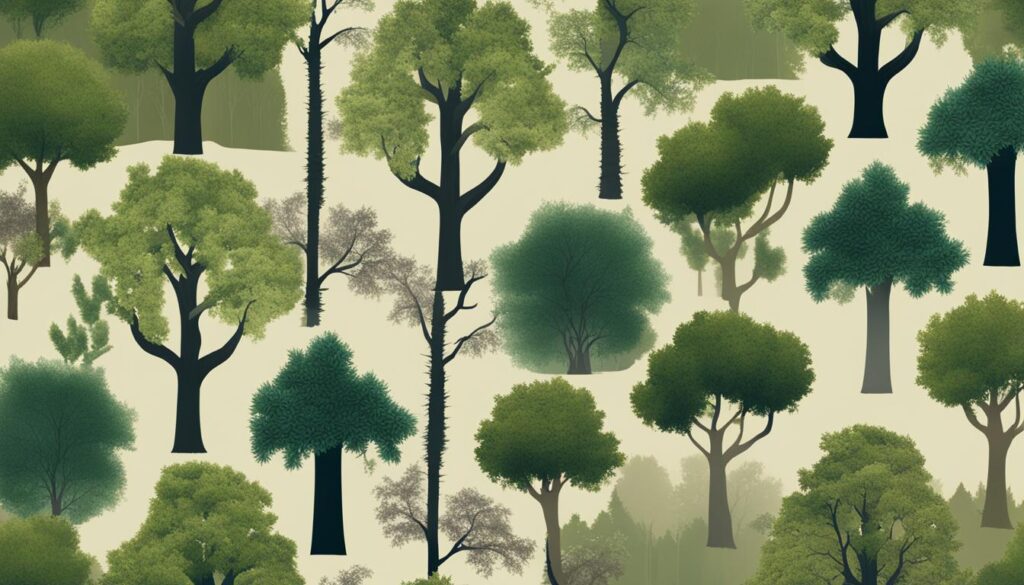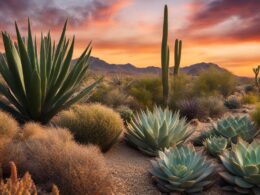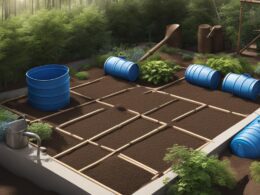In the face of severe drought, maintaining large landscapes can be a challenge. However, by selecting and caring for drought-tolerant trees, you can create thriving and resilient environments in the USA. This guide will provide you with valuable information on choosing the right trees for large landscapes and ensuring their survival even in dry conditions.
Key Takeaways:
- Choosing drought-tolerant trees is crucial for water-wise landscaping in the USA.
- Drought-tolerant trees conserve water and reduce maintenance costs in large landscapes.
- Consider native tree species, small leaves, and multilayered crowns for better drought tolerance.
- Proper watering techniques are essential for the survival and growth of drought-tolerant trees.
- Heat- and drought-tolerant trees like Eastern red cedar and Ginkgo are suitable for large landscapes.
Importance of Drought-Tolerant Trees for Water-Wise Landscaping
Water-wise landscaping has become increasingly important in areas facing drought. By choosing drought-tolerant trees, you can create a beautiful and sustainable landscape while conserving water and reducing maintenance costs. Drought-tolerant trees are specifically adapted to thrive in dry conditions, making them an ideal choice for large landscapes.
When you incorporate drought-tolerant trees into your landscape design, you can significantly reduce the amount of water required for maintenance. These trees have evolved to withstand prolonged periods of drought by developing various adaptations that allow them to conserve water and minimize water loss through transpiration.
Drought-tolerant trees can also improve the overall health of your landscape. Their deep root systems help stabilize the soil and prevent erosion, while their shade can provide relief from the heat and reduce the need for additional irrigation. Additionally, these trees often require less maintenance and are more resistant to pests and diseases, further reducing the need for chemical treatments.
By selecting drought-tolerant trees, you can create a water-wise landscape that not only saves water but also contributes to the overall sustainability of your outdoor space. These trees offer both beauty and practicality, making them an excellent choice for large landscapes.
Incorporating water-wise landscaping practices, including the use of drought-tolerant trees, is not only beneficial for your property but also for the environment. By reducing water consumption, you can help conserve this precious resource and contribute to a more sustainable future.
Benefits of Drought-Tolerant Trees for Water-Wise Landscaping:
- Conserves water by requiring less irrigation
- Reduces maintenance costs and time
- Improves soil stability and prevents erosion
- Provides shade and reduces heat island effect
- Resistant to pests and diseases
By choosing to incorporate drought-tolerant trees into your landscape, you can create an aesthetically pleasing environment that thrives even in water-scarce conditions. These trees offer numerous benefits, ranging from water conservation to improved plant health, making them an essential component of any water-wise landscaping strategy.
Considerations for Selecting Drought-Tolerant Trees
When it comes to choosing drought-tolerant trees for your large landscape, there are several important factors to consider. By selecting the right native tree species and understanding their specific characteristics, you can ensure the success of your drought-tolerant landscaping efforts. Let’s explore some key considerations for selecting these trees.
Native Tree Species
Native tree species are well-suited to the local climate and have adapted to thrive in the specific conditions of your region. They have developed natural defenses against drought and are more likely to withstand dry spells. When selecting drought-tolerant trees, prioritize native species to increase their chances of survival and long-term success.
Leaf Size and Shape
The size and shape of leaves can impact a tree’s water efficiency. Trees with small leaves, such as elm and linden, tend to have better water efficiency as they reduce transpiration, the process by which plants release water vapor. Consider choosing trees with small leaves to maximize water conservation in your landscape.
Crown Structure
The structure of a tree’s crown can also play a role in its ability to tolerate drought. Trees with deep, upright crowns are more effective at capturing and using available water, making them a good choice for water-wise landscaping. Additionally, trees with multilayered crowns, like oaks and hickories, have a higher water efficiency compared to trees with single-layered canopies.
By considering these factors and selecting native tree species with small leaves and deep, upright or multilayered crowns, you can choose drought-tolerant trees that are well-suited to your large landscape. These trees will not only conserve water but also contribute to the overall health and beauty of your outdoor space.
Tips for Watering Drought-Tolerant Trees in Drought-Like Conditions
Proper watering is essential for the health and survival of drought-tolerant trees, both newly planted and established ones. During drought-like conditions, it is crucial to implement techniques that conserve water and meet the specific needs of these trees.
For newly planted trees, it is important to provide regular watering to establish their root systems. Typically, these trees require 2-3 gallons of water per day for the first few weeks. This frequent watering helps the roots penetrate the soil and promotes healthy growth.
On the other hand, established drought-tolerant trees have developed a deeper root system, allowing them to withstand periods of limited water availability. These trees can be watered less frequently, typically 2-3 gallons per week. However, it is important to monitor the soil moisture level and adjust watering accordingly, especially during prolonged drought conditions.
During droughts, it is important to follow local water restrictions to conserve this precious resource. Slow and steady watering techniques are recommended for both newly planted and established trees. This allows water to penetrate deeper into the ground, targeting the root zone and reducing water runoff. Avoiding fast and excessive watering ensures that the water is efficiently utilized by the trees, minimizing wastage.
Table: Watering Recommendations for Drought-Tolerant Trees
| Tree Type | Newly Planted Trees | Established Trees |
|---|---|---|
| Dosage | 2-3 gallons per day for the first few weeks | 2-3 gallons per week |
| Watering Frequency | Daily | Weekly |
| Watering Technique | Slow, deep watering | Slow, deep watering |
By following these watering tips, you can ensure the vitality and resilience of drought-tolerant trees in your landscape, even in drought-like conditions. Conserving water and providing the appropriate amount of moisture will help these trees thrive and contribute to the overall sustainability of your landscaping.
Heat- and Drought-Tolerant Trees for Large Landscapes
When it comes to selecting trees for your large landscape that can withstand both extreme heat and drought conditions, there are several options to consider. These heat-tolerant and drought-resistant trees not only provide shade and beauty but also contribute to the overall health and sustainability of your landscape. Here are some excellent choices to consider:
Cedar (Eastern red cedar)
The Eastern red cedar (Juniperus virginiana) is a versatile evergreen tree that thrives in hot and dry climates. It has excellent heat tolerance and can withstand drought conditions, making it a great choice for large landscapes. The Eastern red cedar is also resistant to pests and diseases, making it low-maintenance and ideal for those looking for an easy-care tree.
Oak (Bur oak)
The Bur oak (Quercus macrocarpa) is a magnificent tree that offers both drought tolerance and the ability to withstand extreme heat. Its large, deeply lobed leaves provide ample shade, making it a welcome addition to any landscape. The Bur oak also has a deep root system, which allows it to extract moisture from deeper soil layers, making it more resilient during drought periods.
Ginkgo
The Ginkgo (Ginkgo biloba) is a unique and beautiful tree known for its fan-shaped leaves and exceptional heat and drought tolerance. It can adapt to various soil conditions and urban environments, making it an ideal choice for large landscapes. The Ginkgo is also resistant to pests and diseases, making it a hardy and reliable tree for your landscape.
Hackberry
The Hackberry (Celtis occidentalis) is a tough and adaptable tree that can withstand heat, drought, and various soil types. It has a dense canopy that provides ample shade, making it an excellent choice for large landscapes. The Hackberry also attracts a variety of birds with its small fruits, adding wildlife value to your landscape.
Red Maple
The Red maple (Acer rubrum) is a popular choice for large landscapes due to its stunning fall color and adaptability to different soil conditions. It has moderate drought tolerance and can withstand heat, making it a reliable choice for regions with dry and hot climates. The Red maple is also known for its fast growth and ability to provide a visual focal point in any landscape.
These heat- and drought-tolerant trees are just a few examples of the numerous options available for large landscapes. By incorporating these trees into your landscape design, you can create a visually appealing and sustainable environment that thrives even in challenging conditions.
If you are interested in learning more about selecting and caring for drought-tolerant trees, continue reading our guide or refer to the table below which provides a summary of the key characteristics of each tree mentioned above.
| Tree | Scientific Name | Heat Tolerance | Drought Tolerance | Other Characteristics |
|---|---|---|---|---|
| Cedar (Eastern red cedar) | Juniperus virginiana | High | High | Pest and disease resistant |
| Oak (Bur oak) | Quercus macrocarpa | High | High | Deep root system |
| Ginkgo | Ginkgo biloba | High | Moderate | Resistant to pests and diseases |
| Hackberry | Celtis occidentalis | Moderate | Moderate | Attracts wildlife |
| Red Maple | Acer rubrum | Moderate | Moderate | Stunning fall color |
Benefits of Drought-Tolerant Trees
Drought-tolerant trees offer numerous benefits for large landscapes, making them a wise choice for water conservation, plant health, and cost-saving. Here are some key advantages:
- Drought Tolerance: One of the primary benefits of drought-tolerant trees is their ability to withstand periods of water scarcity. These trees have adaptations that allow them to survive in dry conditions, such as deep root systems that can access water from lower soil layers.
- Water Conservation: Planting drought-tolerant trees can significantly reduce water usage in landscaping. These trees require less frequent watering compared to water-intensive species, helping to conserve this valuable resource. By selecting and incorporating these trees into your landscape design, you can contribute to a more sustainable water management approach.
- Plant Health: Drought-tolerant trees are generally more resilient and less prone to diseases and pests. Their adapted physiological features enable them to withstand dry periods without compromising their overall health and vigor. By choosing these trees, you can enjoy a healthier and more robust landscape.
- Cost-Saving: Incorporating drought-tolerant trees into your large landscape can lead to long-term cost savings. As these trees require less water and maintenance, you’ll experience reduced water bills and lower maintenance expenses. Additionally, their resistance to diseases and pests can save you money on treatments and tree removal or replacement costs.
Choosing drought-tolerant trees is not only beneficial for your landscape’s well-being but also for the environment as a whole. These trees play a vital role in water conservation efforts, support biodiversity, and contribute to the overall sustainability of your community.
By embracing the benefits of drought-tolerant trees, you can create a beautiful and resilient landscape that thrives even in challenging environmental conditions. The combination of water conservation, improved plant health, and cost savings makes these trees an excellent choice for large landscapes in drought-prone regions.
| Tree Species | Drought Tolerance | Water Conservation Features |
|---|---|---|
| Eastern Red Cedar | High | Deep roots, ability to withstand dry conditions |
| Bur Oak | High | Deep root system, strong tolerance to drought |
| Ginkgo | Moderate to high | Thick leaves, efficient water use |
| Hackberry | Moderate to high | Drought-resistant, adaptable to various soil types |
| Red Maple | Moderate | Deep root system, tolerance to dry spells |
What Makes a Plant Drought Tolerant?
Drought-tolerant plants have evolved various adaptations that enable them to survive and thrive in water-scarce conditions. These adaptations help plants conserve water and withstand drought by reducing water loss and increasing water absorption. Understanding these plant adaptations can assist in selecting the right species for drought-tolerant landscaping.
One important water-saving feature of drought-tolerant plants is their leaf structure. Plants with thick and waxy leaves, such as succulents, are able to retain moisture and minimize water loss through evaporation. Other species have small or thin leaves, which reduces surface area and helps conserve water. Some plants even have silvery foliage, which reflects sunlight and reduces heat absorption, resulting in lower water requirements.
Another crucial adaptation of drought-tolerant plants is their root systems. These plants often have deep, extensive root systems that can reach deep into the soil in search of water sources. Deep roots enable plants to access groundwater, which is less affected by drought conditions near the surface. Additionally, some drought-tolerant plants have the ability to store water within their biomasses, allowing them to survive extended periods without rainfall.
“Drought-tolerant plants have evolved various adaptations that enable them to survive and thrive in water-scarce conditions.”
Overall, the combination of water-saving leaf features and efficient root systems makes drought-tolerant plants well-suited to withstand drought conditions. These adaptations not only help the plants survive but also contribute to their ability to conserve water and maintain their health even in challenging environments.
| Adaptation | Plant Examples |
|---|---|
| Thick and waxy leaves | Succulents, agave |
| Small or thin leaves | Lavender, rosemary |
| Silvery foliage | Dusty miller, lamb’s ear |
| Deep root systems | Blue oak, mesquite |
| Water storage capacity | Aloe, prickly pear cactus |
Drought-Tolerant Plants by Region
When it comes to selecting drought-tolerant plants for your landscaping, it’s important to consider the specific region you are in. Native plants from dry or drought-prone regions are often the best choice, as they have evolved to withstand harsh conditions. However, there are also introduced species that can thrive in dry climates and provide a beautiful addition to your landscape. Here are some examples of drought-tolerant plants for different regions:
California:
In California, where water scarcity is a major concern, native species like the Quercus agrifolia, commonly known as the coast live oak, thrive in dry conditions. With its broad canopy and deep root system, this oak tree is well-suited for large landscapes and provides shade and beauty.
Texas:
For the hot and arid climate of Texas, the Quercus macrocarpa, also known as the bur oak, is an excellent choice. This large and majestic tree is highly adaptable to various soil types and can withstand drought conditions while offering shade and a stunning presence in the landscape.
Southwest:
In the Southwest, where water scarcity is a constant challenge, the Chilopsis linearis, commonly known as the desert willow, is a popular choice. This drought-tolerant tree boasts vibrant flowers and can thrive in the dry and hot climate of the region, making it a beautiful addition to any large landscape.
When selecting drought-tolerant plants for your region, it is essential to consider factors such as climate, soil type, and water availability. Consulting with local horticulturists or landscaping professionals can provide valuable insights and help you make informed decisions for your large landscape.
| Region | Drought-Tolerant Plants |
|---|---|
| California | Quercus agrifolia (Coast live oak) |
| Texas | Quercus macrocarpa (Bur oak) |
| Southwest | Chilopsis linearis (Desert willow) |
By selecting the right drought-tolerant plants for your region, you can create a resilient and water-efficient landscape that thrives even in times of drought. These plants not only contribute to the sustainability of large landscapes but also provide aesthetic beauty and enhance the ecological balance of the environment.
Conclusion
Drought-tolerant landscaping is essential for creating water-efficient and sustainable landscapes, especially in regions facing drought. By incorporating drought-tolerant trees and plants into your large landscape design, you can significantly reduce water requirements and maintenance costs.
Choosing and caring for drought-tolerant trees not only helps conserve water but also adds visual appeal and ecological benefits to your landscape. These trees are adapted to withstand dry conditions, requiring less water and being more resistant to disease and pests.
Creating sustainable landscapes with drought-tolerant plants and trees is a smart choice for both the environment and your budget. By implementing water-efficient design strategies and selecting native species, you can achieve a beautiful and thriving landscape while minimizing water usage and long-term costs.
Remember, in regions where drought is a concern, selecting drought-tolerant trees and plants is key to maintaining a healthy and flourishing landscape. With their ability to thrive in water-scarce conditions, these trees contribute to a more sustainable future for large landscapes and promote water efficiency.
Which Drought-Resistant Trees Are Best Suited for Large Landscapes in the USA?
When selecting drought-resistant trees for xeriscaping in large landscapes in the USA, it’s important to consider options like the Desert Willow, Palo Verde, and Olive trees. These trees are well-suited for dry environments and can thrive in the arid conditions found in many parts of the country.
FAQ
Why are drought-tolerant trees important for water-wise landscaping?
Drought-tolerant trees conserve water and reduce maintenance costs in regions facing drought.
What should I consider when selecting drought-tolerant trees?
It is important to choose native species adapted to the local climate and consider factors like small leaves and deep, upright crowns.
How should I water newly planted and established drought-tolerant trees?
Newly planted trees require more frequent watering initially, while established trees can be watered less often. Follow local water restrictions and use slow watering techniques.
Can you recommend some heat- and drought-tolerant trees for large landscapes?
Examples of heat- and drought-tolerant trees include the Eastern red cedar, Bur oak, Ginkgo, Hackberry, and Red maple.
What are the benefits of planting drought-tolerant trees?
Drought-tolerant trees require less water, have lower maintenance needs, and are more resistant to disease and pests, saving money in the long run.
What adaptations do drought-tolerant plants have?
Drought-tolerant plants have thick and waxy leaves, small or thin leaves, silvery foliage, deep root systems, and the ability to store water, helping them survive in water-scarce conditions.
Are there regional variations in drought-tolerant plants?
Yes, native plants from dry or drought-prone regions are often drought-tolerant, but there are also introduced species that can thrive in dry climates, such as Quercus agrifolia in California, Quercus macrocarpa in Texas, and Chilopsis linearis in the Southwest.






